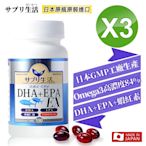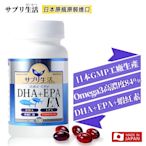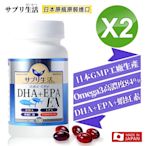日本魚油 相關
廣告過去一個月已有 超過 10 萬 位使用者造訪過 shop.vitabox.com.tw
採用純淨海域小型魚種,24 小時內提煉,經過多重專利製程,最後放入 PTP 獨立排裝,抗潮抗氧化. 確保魚油營養成分在新鮮的狀態下完整保留,打造出高濃度、高新鮮度、安全的魚油,補充純淨營養。
- 45 天滿意保證,開封也能退
三專管制,100%收到全新商品
無條件退貨是我們負責的方式
- 天然無添加主張
全品項選用天然來源原料
用純淨無添加保健品補充營養
- 獨家 VITASYNERGY® 配方
扭轉高劑量才有效,我們的獨家配方
讓營養達到 1 + 1 大於 2 的功效
- 斷絕食安風暴的 4 個保障
全品項逐批通過 SGS 安心測試
BSI 英國標準協會的 360 度全方位稽核
- 45 天滿意保證,開封也能退
過去一個月已有 超過 1 萬 位使用者造訪過 daikenshop.com
德國頂級魚油-高濃度魚油首選!rTG型式好吸收、小顆粒好吞嚥,有效維持思緒清晰,調節生理機能. 連續榮獲世界頂級金獎,Omega-3高達97.7%!有效維持思緒靈活,促進新陳代謝,維持健康。
魚油只靠濃度沒有用!營養完整發揮+複方功效,才是真正有效關鍵,DHA芝麻明有感滿意度超過9成! 本檔活動數量有限,890元絕佳體驗機會,日本精心研發,複方組合,一次兼顧睡眠,條理及順暢健康
搜尋結果
 $3868$4896【補充生活-サプリ生活】日本深海魚油DHA+EPA (150粒/瓶) x6瓶購物中心折價券
$3868$4896【補充生活-サプリ生活】日本深海魚油DHA+EPA (150粒/瓶) x6瓶購物中心折價券 $2486$3146【補充生活-サプリ生活】日本深海魚油DHA+EPA EX 150粒/瓶 x3瓶 (添加蝦紅素)購物中心折價券
$2486$3146【補充生活-サプリ生活】日本深海魚油DHA+EPA EX 150粒/瓶 x3瓶 (添加蝦紅素)購物中心折價券 $1180【補充生活-サプリ生活】日本深海魚油DHA+EPA EX 150粒/瓶 (添加蝦紅素)購物中心
$1180【補充生活-サプリ生活】日本深海魚油DHA+EPA EX 150粒/瓶 (添加蝦紅素)購物中心 $4448$5630【補充生活-サプリ生活】日本深海魚油DHA+EPA EX 150粒/瓶 x6瓶 (添加蝦紅素)購物中心折價券
$4448$5630【補充生活-サプリ生活】日本深海魚油DHA+EPA EX 150粒/瓶 x6瓶 (添加蝦紅素)購物中心折價券![【補充生活-サプリ生活】日本深海魚油DHA+EPA (150粒/瓶) x2瓶 【補充生活-サプリ生活】日本深海魚油DHA+EPA (150粒/瓶) x2瓶]() $1517$1920【補充生活-サプリ生活】日本深海魚油DHA+EPA (150粒/瓶) x2瓶購物中心折價券
$1517$1920【補充生活-サプリ生活】日本深海魚油DHA+EPA (150粒/瓶) x2瓶購物中心折價券![【補充生活-サプリ生活】日本深海魚油DHA+EPA EX 150粒/瓶 x2瓶 (添加蝦紅素) 【補充生活-サプリ生活】日本深海魚油DHA+EPA EX 150粒/瓶 x2瓶 (添加蝦紅素)]() $2208【補充生活-サプリ生活】日本深海魚油DHA+EPA EX 150粒/瓶 x2瓶 (添加蝦紅素)購物中心
$2208【補充生活-サプリ生活】日本深海魚油DHA+EPA EX 150粒/瓶 x2瓶 (添加蝦紅素)購物中心![【補充生活-サプリ生活】日本深海魚油DHA+EPA (150粒/瓶) x3瓶 【補充生活-サプリ生活】日本深海魚油DHA+EPA (150粒/瓶) x3瓶]() $2162$2736【補充生活-サプリ生活】日本深海魚油DHA+EPA (150粒/瓶) x3瓶購物中心折價券
$2162$2736【補充生活-サプリ生活】日本深海魚油DHA+EPA (150粒/瓶) x3瓶購物中心折價券![附發票[快速出貨]日本SUNTORY三得利 魚油 DHA&EPA+芝麻明E 【隨身包裝x10包】 附發票[快速出貨]日本SUNTORY三得利 魚油 DHA&EPA+芝麻明E 【隨身包裝x10包】]() $490附發票[快速出貨]日本SUNTORY三得利 魚油 DHA&EPA+芝麻明E 【隨身包裝x10包】附發票[快速出貨]
$490附發票[快速出貨]日本SUNTORY三得利 魚油 DHA&EPA+芝麻明E 【隨身包裝x10包】附發票[快速出貨]![日本SUNTORY 三得利 魚油 DHA & EPA + 芝麻明 120顆 防偽標籤 最新效期 日本SUNTORY 三得利 魚油 DHA & EPA + 芝麻明 120顆 防偽標籤 最新效期]() $1559日本SUNTORY 三得利 魚油 DHA & EPA + 芝麻明 120顆 防偽標籤 最新效期JP日本專業代購
$1559日本SUNTORY 三得利 魚油 DHA & EPA + 芝麻明 120顆 防偽標籤 最新效期JP日本專業代購![附發票[快速出貨]日本SUNTORY三得利 魚油 DHA&EPA+芝麻明E x 1包【隨身包裝】 附發票[快速出貨]日本SUNTORY三得利 魚油 DHA&EPA+芝麻明E x 1包【隨身包裝】]() $49附發票[快速出貨]日本SUNTORY三得利 魚油 DHA&EPA+芝麻明E x 1包【隨身包裝】附發票[快速出貨]
$49附發票[快速出貨]日本SUNTORY三得利 魚油 DHA&EPA+芝麻明E x 1包【隨身包裝】附發票[快速出貨]![當日出貨 升級版 最新效期25/9 日本 三得利 Suntory 魚油 DHA & EPA 芝麻明EX 240粒 60日 當日出貨 升級版 最新效期25/9 日本 三得利 Suntory 魚油 DHA & EPA 芝麻明EX 240粒 60日]() $2500當日出貨 升級版 最新效期25/9 日本 三得利 Suntory 魚油 DHA & EPA 芝麻明EX 240粒 60日希喆藝術
$2500當日出貨 升級版 最新效期25/9 日本 三得利 Suntory 魚油 DHA & EPA 芝麻明EX 240粒 60日希喆藝術![附發票[快速出貨]日本SUNTORY三得利 魚油 DHA&EPA+芝麻明E x 30日份(120顆)【隨身包裝】 附發票[快速出貨]日本SUNTORY三得利 魚油 DHA&EPA+芝麻明E x 30日份(120顆)【隨身包裝】]() $1450附發票[快速出貨]日本SUNTORY三得利 魚油 DHA&EPA+芝麻明E x 30日份(120顆)【隨身包裝】附發票[快速出貨]
$1450附發票[快速出貨]日本SUNTORY三得利 魚油 DHA&EPA+芝麻明E x 30日份(120顆)【隨身包裝】附發票[快速出貨]
4 天前 · Bird Tanchō (red-crowned crane, Grus japonensis) Flower Hamanasu (rugosa rose, Rosa rugosa) Mascot Kyun-chan (キュンちゃん) Tree Ezomatsu (Jezo spruce, Picea jezoensis) Hokkaido (Japanese: 北海道, Hepburn: Hokkaidō, pronounced [hokka idoː] , lit. 'Northern Sea Circuit') is the second-largest island of Japan and comprises the largest and northernmost prefecture, making up its own ...
1 天前 · Unit 731 (Japanese: 731部隊, Hepburn: Nana-san-ichi Butai), short for Manchu Detachment 731 and also known as the Kamo Detachment: 198 and the Ishii Unit, was a covert biological and chemical warfare research and development unit of the Imperial Japanese Army that engaged in lethal human experimentation and biological weapons manufacturing during the Second Sino-Japanese War (1937–1945 ...
- 1936–1945
- Biological weapons, Chemical weapons, Explosives
- Estimated 3,000 to 300,000, 400,000 or higher from biological warfare, Over 3,000 from inside experiments from each unit (not including branches, 1940–1945 only): 20 , At least 10,000 prisoners died, No documented survivors
2 天前 · Japanese (日本語, Nihongo, [ɲihoŋɡo] ⓘ) is the principal language of the Japonic language family spoken by the Japanese people. It has around 120 million speakers, primarily in Japan, the only country where it is the national language, and within the Japanese diaspora worldwide. The Japonic family also includes the Ryukyuan languages ...
2 天前 · Japan portal. v. t. e. The first human inhabitants of the Japanese archipelago have been traced to the Paleolithic, around 38–39,000 years ago. [1] The Jōmon period, named after its cord-marked pottery, was followed by the Yayoi period in the first millennium BC when new inventions were introduced from Asia.
2 天前 · Tokugawa Ieyasu [a] ( 徳川 家康, January 31, 1543 – June 1, 1616; born Matsudaira Takechiyo and later taking other names [b]) was the founder and first shōgun of the Tokugawa Shogunate of Japan, which ruled from 1603 until the Meiji Restoration in 1868. He was one of the three "Great Unifiers" of Japan, along with his former lord Oda ...
2 天前 · Shinto. The torii gateway to the Itsukushima Shrine in Hiroshima Prefecture, Japan, one of the most famous examples of torii in the country. [1] Torii mark the entrance to Shinto shrines and are recognizable symbols of the religion. Shinto ( Japanese: 神道, romanized : Shintō) is a religion originating from Japan.
3 天前 · Marginal seas. v. t. e. The Pacific Ocean is the largest and deepest of Earth's five oceanic divisions. It extends from the Arctic Ocean in the north to the Southern Ocean (or, depending on definition, to Antarctica) in the south, and is bounded by the continents of Asia and Australia in the west and the Americas in the east.







![附發票[快速出貨]日本SUNTORY三得利 魚油 DHA&EPA+芝麻明E 【隨身包裝x10包】 附發票[快速出貨]日本SUNTORY三得利 魚油 DHA&EPA+芝麻明E 【隨身包裝x10包】](https://s.yimg.com/fz/api/res/1.2/KRWh9gCIRM8ixi3_nxsz.Q--~C/YXBwaWQ9c3JjaGRkO2ZpPWZpbGw7aD0xNDY7cT04MDt3PTE0Ng--/https://ct.yimg.com/xd/api/res/1.2/Y.3Ru4fNtKPE.MLtIXJpZg--/YXBwaWQ9eXR3YXVjdGlvbnNlcnZpY2U7aD0zNzc7cT04NTtyb3RhdGU9YXV0bzt3PTQwMA--/https://s.yimg.com/ob/image/3de75886-dd96-4184-b455-13e670621290.jpg)

![附發票[快速出貨]日本SUNTORY三得利 魚油 DHA&EPA+芝麻明E x 1包【隨身包裝】 附發票[快速出貨]日本SUNTORY三得利 魚油 DHA&EPA+芝麻明E x 1包【隨身包裝】](https://s.yimg.com/fz/api/res/1.2/4xYsXWKYqigX_rslIPPJaQ--~C/YXBwaWQ9c3JjaGRkO2ZpPWZpbGw7aD0xNDY7cT04MDt3PTE0Ng--/https://ct.yimg.com/xd/api/res/1.2/Lck7tpf0d1quzfYlioVGPA--/YXBwaWQ9eXR3YXVjdGlvbnNlcnZpY2U7aD0zNzc7cT04NTtyb3RhdGU9YXV0bzt3PTQwMA--/https://s.yimg.com/ob/image/8cc1cdf9-26ad-4246-aac3-5efb154650ad.jpg)

![附發票[快速出貨]日本SUNTORY三得利 魚油 DHA&EPA+芝麻明E x 30日份(120顆)【隨身包裝】 附發票[快速出貨]日本SUNTORY三得利 魚油 DHA&EPA+芝麻明E x 30日份(120顆)【隨身包裝】](https://s.yimg.com/fz/api/res/1.2/.ykjHqu3C4KGY7nMIO5RGA--~C/YXBwaWQ9c3JjaGRkO2ZpPWZpbGw7aD0xNDY7cT04MDt3PTE0Ng--/https://ct.yimg.com/xd/api/res/1.2/K.fOk0PYX19Ry.7Zqj17rA--/YXBwaWQ9eXR3YXVjdGlvbnNlcnZpY2U7aD0yNTg7cT04NTtyb3RhdGU9YXV0bzt3PTQwMA--/https://s.yimg.com/ob/image/6916c643-c030-4868-924e-b451fc4dcff3.jpg)
